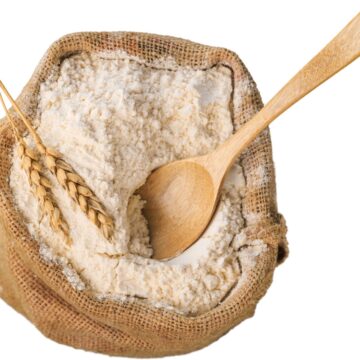This guide will teach you exactly how to store flour long term so that it stays fresh and ready to use at a moment's notice. Not only will you learn the best way to store flour long term but it will also tell you how long will flour last using each method. There are many reasons you might decide that long term storage of flour is right for you. Flour is a main ingredient for most baked goods, so it's important to have it on hand.

Jump to:
- How to store flour long term?
- Why long term flour storage might be right for you
- Does flour go bad?
- Why does flour go bad?
- How long does flour last?
- Why is flour storage important?
- How can I tell if the flour is bad?
- 7 Ways to Store Flour
- 1. Original packaging
- 2. Airtight container in the pantry
- 3. Airtight container in the refrigerator
- 4. Airtight container in the freezer
- 5. Vacuum sealed bags
- 6. Food grade buckets (with oxygen absorbers)
- 7. Mylar bags (with oxygen absorbers)
- How to store flour to keep it fresh FAQs
- Recommended equipment for storing flour
- Conclusions
- More Baking Guides
- How to store flour long term (Ultimate Guide)
How to store flour long term?
Knowing how to store flour properly is essential to keeping it fresh and usable. There is a wide range of time that flours can last; from six months to more than 10 years. How long your flour lasts depends on the type of flour you're using and the storage method you choose.
Regardless of your storage method, it's most important to remember that you block out access to light, oxygen, moisture, and pests if you want your flour to last. These factors can all shorten the shelf life of your flour and cause it to go bad much earlier than you anticipated.
Why long term flour storage might be right for you
Cost effective- If you purchase flour in bulk as a cost-saving method, you'll want to be sure that you properly care for your investment. It can be very cost effective to buy large amounts of flour for later use, especially for those who bake often.
Convenience- For professional bakers and those who bake a lot at home, storing flour long term is a great way to avoid running to the store frequently. If you know how to store bulk flour, you won't need to purchase smaller bags nearly as often. This will save you time because you will always have it on hand whenever you need it.
Food security- Storing flour in bulk long term can be part of a food security strategy for some individuals. In areas that are prone to shortages or that face frequent weather emergencies, having a reserve of this basic ingredient is an excellent way to support your family's food needs.

Does flour go bad?
There are different elements that can cause flour to go bad; mold from exposure to humidity, oxidation from exposure to the open air, and even bugs that can creep into your cabinets and take refuge in your open flour containers. However, it's important to know how to properly store flour long term so that you can extend its shelf life and keep it fresh despite the factors working against it.
Why does flour go bad?
Exposure to light and air
Flour is best stored in a cool, dark place like a cabinet or pantry. Light exposure can cause the starch and proteins to break down. Overexposure to light can affect its taste and potentially even how the gluten develops in certain recipes.
It can also cause heat to build within the container, which can affect the moisture level and cause the flour to go rancid. Additionally, long term exposure to air can also cause clumping and encourage your flour to absorb nearby odors.
Excess moisture
Because flour is made up of starches, excess moisture can cause the growth of mold and bacteria. Flour is considered a raw ingredient until it has been heat treated, so moisture can encourage the growth of harmful bacteria that thrive in warm, moist environments.
Pests
To our surprise, pests can sometimes pop up in flour. Just because you do not have any in your home doesn't mean they won't occasionally occur in flour. They can end up in flour packaging at many stages, from the wheat field itself, throughout the milling process, and even large storage facilities can be breeding grounds for pests and their eggs.
Luckily, storing flour properly can help. Adequate home storage can prevent pests from spreading if they are detected in a batch of flour. It can also keep flour safe from additional pests, such as ants or moths.
How long does flour last?
Most people don't keep track of their flour's expiration date and, instead, just keep the flour in their pantry until it's all used up. This might leave you wondering how long can you keep flour?
Generally, refined white flour lasts for up to about 6 months in its original packaging, which is longer than whole wheat flour at closer to 3 months. Gluten free flour such as rice flour, coconut flour, and almond flour can also be stored safely for about 3 months because of their different ingredients and moisture levels. Always be sure to check the best-by-date and storage recommendations for each brand.

Why is flour storage important?
Quality and freshness
Flour storage is important because it will prevent dust, dirt, and pests from getting into your flour. It will also keep it tasting its best, which is important since it's often the base ingredient in baking. Whether you're making brioche bread or Nutella cupcakes, you simply need flour. Knowing how to store flour to prevent bugs will protect your recipes from unwanted intruders.
Food safety
Knowing how to store flour long term properly will help avoid bacteria and mold growth. These can cause illness if consumed, so being able to identify if your flour has gone bad will protect you from unnecessary health risks.
Recipe success
Improperly stored flour can lose flavor and have structural issues, which can cause your recipe to fail. To ensure success, you should understand how long you can store flour so that your ingredients are baking-ready every time. Be sure to check out my flour guide for more information on using flour in baking recipes.
Cost effectiveness
Thoughtful storage can extend the shelf life of flour. This will save you money in replacements and allow you to buy in larger quantities, which will be more economical in the long run.
How can I tell if the flour is bad?
It's important to inspect your flour regularly to determine whether it's still safe to use. By looking at your flour, feeling it, and smelling it, you might be able to pick up on key signs that your flour has gone bad.
For example, fresh flour has a white appearance and is dry and fluffy. If you feel yours and find that it is holding on to excess moisture, it's best to throw it away. Additionally, flour that is safe to use has a very neutral smell. If your flour has a stale or sour odor, it has gone bad.
7 Ways to Store Flour
1. Original packaging
Shelf life: Up to 6 months
Flour stored in the package it came with can last for a while, depending on if it's opened or not. However, this is the least safe method for storing flour because opening flour bags often result in rips and the inability to reseal them. This leaves the flour open to contamination and bugs. Storing a bay leaf in the bag can help deter pests, though.
This method of storage provides quick access to the expiration date and nutrition information label. It's a cost effective method that can be beneficial for those with limited space, but it is not ideal for extended storage. If the bag does tear when opening, it's important to transfer the flour to a better storage option, such as a container or storage bag.
2. Airtight container in the pantry
Shelf life: 6-8 months
How long does flour keep in the pantry? Flour can last in an airtight container in the pantry for 6-8 months if kept in a cool dark place. This is a good option for those who casually bake because it makes your flour easily accessible. Storing flour in the pantry is a good idea for those who purchase only a few pounds of flour at a time. Using an airtight container rather than the original packaging will help the flour stay fresh and retain its texture and taste.
Storing flour in an air tight container can also help your pantry look more neat and organized. If storing multiple types of flour, such as self rising flour, bread flour and white flour, it's important to label them properly because they all look very similar.
3. Airtight container in the refrigerator
Shelf life: Up to 1 year
Storing flour in an air tight container in the refrigerator can be a good way to preserve its freshness. If you don't use flour often, this can be a good option, especially in smaller quantities. The downside is that it does take up a significant amount of space to store larger amounts, so if you have a small fridge, this may not be a good idea. If your container isn't perfectly airtight, it can also allow smells and moisture to seep into your flour.
4. Airtight container in the freezer
Shelf life: Up to 2 years
Knowing how to store flour long term in freezer is an excellent option for those who enjoy baking but don't do it often. Storing flour in the freezer will kill insect eggs that may be in the flour. Freezing the flour will also prevent it from going rancid and prevent it from absorbing the odors of other food.
It's important to use an airtight freezer safe container that fits the amount of flour as close as possible and does not leave excess space at the top of the container. This extends the length of how long is flour good for when kept in the freezer. This storage option can also take up a lot of space, so it may not be ideal for those with a small freezer. When considering options for how to store flour in freezer spaces long term, you can alternatively keep it in freezer ziplock bags to save space.
5. Vacuum sealed bags
Shelf life: Up to 2 years
Vacuum sealing flour is an effective storage method because it removes the oxygen from the bag in order to keep the flour fresh for longer. You can use a vacuum sealer to preserve flour for up to 2 years. This investment also uses less space than containers and food-grade buckets.
In order to effectively vacuum seal flour, you'll want to make sure not to place it directly into the vacuum seal bag. This would run the risk of having the vacuum suck up the flour itself. Instead, place the flour in a separate bag or keep it in its original packaging before adding it to vacuum sealer bags.
6. Food grade buckets (with oxygen absorbers)
Shelf life: 5+ years
Wonder how to store flour for 5 years? Storing flour in food grade buckets is an excellent way to extend the shelf life of flour. Using these durable plastic containers is a great way to keep your flour free from pests, excess moisture, and light.
This method can be more expensive than other options because you'll need to use oxygen absorbers and high quality food grade buckets. This is how to store flour long term in buckets. Using oxygen absorbers reduces the air in the container, which helps extend freshness. Food grade buckets are specifically made to be non-toxic and safe for long term food storage. One main drawback is that the buckets can also take up a lot of space compared to other methods.
7. Mylar bags (with oxygen absorbers)
Shelf life: 10+ years
Wondering how to store flour long term in mylar bags? A mylar bag is excellent for long term food storage, including long term storage of flour and sugar. They're made up of several layers of laminated plastic and have a foil exterior. Using mylar bags with oxygen absorbers is an excellent way to store flour long term because they absorb excess moisture and prevent mold growth.
This long term storage method has a bigger start up cost than airtight containers but will keep flour fresh for much longer. It also has a relatively low cost compared to storing flour in buckets. Mylar bags can be a great option for those with less available space and your flour can be portioned off into sizes that make the most sense with your baking frequency. So now you know that mylar bags are the best option to preserve flour for 10 years.
How to store flour to keep it fresh FAQs
Because of its higher fat content, whole wheat flours go bad more quickly than all purpose flour. It takes about 3-6 months for whole wheat flour to expire at room temperature and about one year when stored in the refrigerator or freezer.
To really test the limits of how long can flour last, your freezer is one of the best solutions for flour long term storage. In the freezer, the flour shelf life greatly increases, allowing the perfect long term storage solution. So how long can you store flour in your freezer? The shelf life flour that's been frozen has is about 2 years.
If stored at room temperature, self-rising flour can last about six months. When stored in the refrigerator, you have a shelf life of one year, and in the freezer, closer to two years. However, if you use expired self rising flour in your recipes, you'll end up with baked goods that do not rise much at all.
You might be asking yourself, is it safe to store flour in plastic container? Both glass and plastic containers are perfect for storing flour long term. The most important factor is that the container is air tight and sturdy. Some bakers might prefer plastic containers to eliminate the risk of glass shattering, while others might prefer glass containers because of their durability.
Pests, like weevils, are a concern of anyone storing flour. The best way to prevent them is by transferring your flour to an airtight container. This prevents any bugs from nesting in your flour and ruining it for future use.
Recommended equipment for storing flour
Airtight freezer safe container
Conclusions
The best way to store flour long term depends on how much flour you are storing and how long you want to store it.
For the casual baker, storing your flour in an airtight container in the pantry is just fine. You can switch it out every few months and have quick and easy access to it.
If you really want to load up on flour, perhaps to ensure food security, you'll want a longer lasting solution that will keep your flour fresh until you're ready to use it. Mylar bags with oxygen absorbers might be your best option, and it's a flour storage solution you can trust to keep out oxygen, moisture, light, and pests.
Regardless of how you choose to store your flour, you'll want to make sure to inspect it regularly to make sure no insects have invaded your stash. If they do make it into your flour, you will, unfortunately, have to throw it away immediately.
More Baking Guides

How to store flour long term (Ultimate Guide)
Equipment
Ingredients
- 1 cup All-purpose flour
US customary cup measurement is an indicative figure only. Measure the ingredients with a digital scale by weight (gram). Baking is art but also science which requires precision and accuracy.
Instructions
How to store flour long term
Original package
- Shelf life up to 6 months. Storing flour in the original packaging is the least safe method because opening flour bags often result in rips and the inability to reseal them.
Airtight container in the pantry
- Shelf life up to 6-8 months. Using an airtight container rather than the original packaging will help the flour stay fresh and retain its texture and taste.
Airtight container in the refrigerator
- Shelf life up to 1 year. Storing flour in an air tight container in the refrigerator can be a good way to preserve its freshness longer.
Airtight container in the freezer
- Shelf life up to 2 years. Freezer is an excellent option for storing flour long term. Freezing the flour will also prevent it from going rancid and prevent it from absorbing the odors of other food.
Vacuum sealed bag
- Shelf life up to 2 years. Vacuum sealing flour is an effective storage method because it removes the oxygen from the bag in order to keep the flour fresh for longer. This investment also uses less space than containers and food-grade buckets.
Food grade buckets
- Shelf life up to 5 years. Storing flour in food grade buckets is an excellent way to extend the shelf life of flour. Using these durable plastic containers is a great way to keep your flour free from pests, excess moisture, and light.
Mylar bag
- Shelf life up to 10 years. A mylar bag is excellent for long term food storage, including long term storage of flour and sugar. They're made up of several layers of laminated plastic and have a foil exterior. Using mylar bags with oxygen absorbers is an excellent way to store flour because they absorb excess moisture and prevent mold growth. Mylar bags are the best option to preserve flour for 10 years.







Leave a Reply